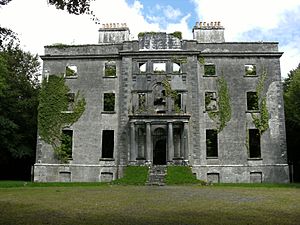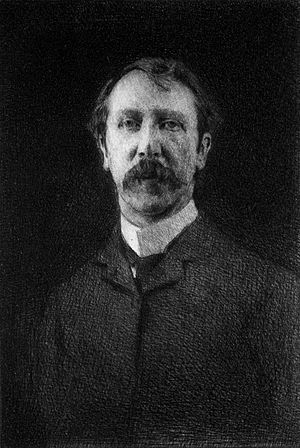George Moore (novelist) facts for kids
Quick facts for kids
George Moore
|
|
|---|---|
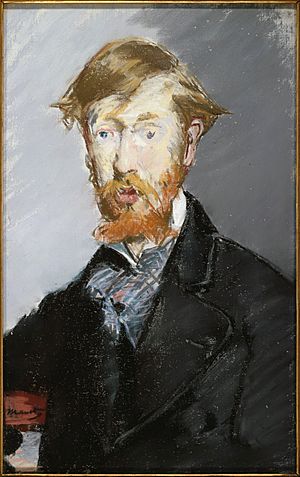
George Moore by Edouard Manet, 1879
|
|
| Born | George Augustus Moore 24 February 1852 Moore Hall, County Mayo, Ireland |
| Died | 21 January 1933 (aged 80) London, England |
| Resting place | Castle Island, County Mayo, Ireland |
| Occupation | short-story writer, poet, art critic, memoirist and dramatist |
| Language | English |
| Alma mater | National Art Training School |
| Period | 1878–1933 |
| Literary movement | Celtic Revival |
| Notable works | Confessions of a Young Man, Esther Waters |
| Relatives | John Moore (granduncle) Maurice George Moore |
George Augustus Moore (born February 24, 1852 – died January 21, 1933) was an Irish writer. He wrote novels, short stories, poems, and plays. He was also an art critic and wrote about his own life.
George Moore came from a family who owned land in County Mayo, Ireland. They lived at Moore Hall. When he was young, he wanted to be a painter. He studied art in Paris in the 1870s. There, he met many important French artists and writers.
He was one of the first English writers to learn from French "realist" writers. These writers tried to show life as it really was. George Moore's work influenced other famous writers like James Joyce. Many people see him as the first great modern Irish novelist.
Contents
George Moore's Life
His Family and Home
George Moore's family lived at Moore Hall in County Mayo for nearly 100 years. His great-grandfather built the house. His grandfather was a friend of the writer Maria Edgeworth. George's great-uncle, John Moore, was a leader in the short-lived Irish Republic in 1798.
George's father, George Henry Moore, was a politician. He was known as a fair landlord. He worked to protect the rights of people who rented land from him.
His Early Years
George Moore was born at Moore Hall in 1852. As a child, he loved reading novels by Walter Scott. He spent a lot of time outdoors with his brother, Maurice George Moore. He also became friends with young Willie and Oscar Wilde. They spent summers at a nearby place called Moytura.
George's formal schooling started at St. Mary's College, Oscott. This was a Catholic boarding school in England. He was not a good student and was unhappy there. In 1867, he was expelled for "idleness." He then returned home to Mayo.
London and Paris Adventures
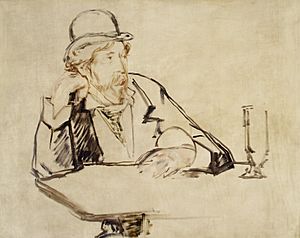
In 1869, George's family moved to London. His father wanted him to join the military. But George was not interested. His father died in 1870, and George inherited the family estate. He let his brother Maurice manage it.
In 1873, George moved to Paris to study art. He met many famous artists and writers there. These included Pissarro, Degas, Renoir, Monet, and Zola. Zola became a very important influence on George's writing.
While in Paris, George published his first book of poems in 1877. It was called The Flowers of Passion. Critics did not like it, and George removed the book from sale. In 1880, he had to return to Ireland to deal with family debts. While there, he decided to stop painting and become a writer.
He moved to London and published another poetry book in 1881. In 1886, he published Confessions of a Young Man. This book was about his time in Paris and London. It also included his thoughts on literature. Many people praised it as an important book.
Back to Dublin and Irish Writing
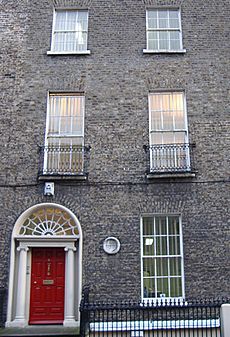
In 1901, George Moore moved back to Dublin. His friend Edward Martyn suggested it. Martyn was involved in Ireland's cultural and theater movements. He was working with Lady Gregory and William Butler Yeats to start the Irish Literary Theatre. George soon became very involved in this project.
His play, The Bending of the Bough (1900), was performed by the theater company. This play was important because it brought realism to Irish literature. He also co-wrote a play called Diarmuid and Grania with Yeats in 1901.
Around this time, George published two books set in Ireland. One was a collection of short stories called The Untilled Field (1903). The other was a novel, The Lake (1905). The Untilled Field talked about how the church affected Irish villagers. It also discussed people leaving Ireland. These stories are seen by some as the start of the Irish short story as a literary style.
In 1903, George Moore changed his religion to Protestant. He announced this in a newspaper. He stayed in Dublin until 1911. In 1914, he published Hail and Farewell. This book was a memoir about his time in Dublin. It made some of his former friends angry.
Later Life and Legacy

George Moore returned to London in 1911. He lived there for most of the rest of his life. In 1913, he traveled to Jerusalem for research. He wrote a novel called The Brook Kerith (1916). This book caused some discussion because of its story.
Sadly, Moore Hall, his family home, was burned down in 1923. This happened during the Irish Civil War. George later received money from the government for the damage. He also sold a large part of his family's land.
George Moore was friends with many artists in London and Paris. He had a long friendship with Maud, Lady Cunard. He took a special interest in the education of Maud's daughter, Nancy Cunard.
George Moore's last novel, Aphrodite in Aulis, was published in 1930. He died in London in 1933. His ashes were buried on Castle Island in Lough Carra. This spot overlooks the ruins of Moore Hall. A blue plaque marks his former home in London.
His Works
- Flowers of Passion (1878)
- Martin Luther: A Tragedy in Five Acts (1879)
- Pagan Poems (1881)
- A Modern Lover (1883)
- A Mummer's Wife (1885)
- Literature at Nurse (1885)
- A Drama in Muslin (1886)
- A Mere Accident (1887)
- Parnell and His Island (1887)
- Confessions of a Young Man (1888)
- Spring Days (1888)
- Mike Fletcher (1889)
- Impressions and Opinions (1891)
- Vain Fortune (1891)
- Modern Painting (1893)
- The Strike at Arlingford (1893)
- Esther Waters (1894)
- Celibates (1895)
- Evelyn Innes (1898)
- The Bending of the Bough (1900)
- Sister Teresa (1901)
- The Untilled Field (1903)
- The Lake (1905)
- Memoirs of My Dead Life (1906)
- The Apostle: A Drama in Three Acts (1911)
- Hail and Farewell (1911, 1912, 1914)
- Elizabeth Cooper (1913)
- Muslin (1915)
- The Brook Kerith: A Syrian Story (1916)
- Lewis Seymour and Some Women (1917)
- A Story-Teller's Holiday (1918)
- Avowals (1919)
- The Coming of Gabrielle (1920)
- Heloise and Abelard (1921)
- In Single Strictness (1922)
- Conversations in Ebury Street (1924)
- Pure Poetry: An Anthology (1924)
- The Pastoral Loves of Daphnis and Chloe (1924)
- Daphnis and Chloe, Peronnik the Fool (1924)
- Ulick and Soracha (1926)
- Celibate Lives (1927) (This includes the short story "Albert Nobbs," which became a film in 2011.)
- The Making of an Immortal (1927)
- The Passing of the Essenes: A Drama in Three Acts (1930)
- Aphrodite in Aulis (1930)
- The Talking Pine (1931)
- A Communication to My Friends (1933)
- Diarmuid and Grania: A Play in Three Acts (co-written with W. B. Yeats, 1974)
Images for kids
See also
 In Spanish: George Moore para niños
In Spanish: George Moore para niños


